Fungal Fruitings of Santa Barbara
My name is Stella Scheim, and I’m a senior in the Quasars to Sea Stars program, a three- to four-year internship program here at the Museum that allows high schoolers to explore science and nature through hands-on learning. Each summer, Quasars create a project that they present in August; first years collaborate on creating an original museum as they learn about the inner workings of our own, and second and third years present a literature review of a topic of their choice that relates to summer classes taught by our Teen Programs intern. Seniors, though, are tasked with something with a bit of larger scope: an original research project, mentored by an expert in the field, that they work on throughout the year.
For my project, I focused on a long term passion of mine–fungi.
I was mentored by the awesome mycologist Laura Bogar, Ph.D., and counseled by Museum Librarian Terri Sheridan and Teen Programs Manager Charlie Thrift, all of whom this project would not have been possible without. So get ready folks, because you’re in for a tale of one person’s irrational adoration of Kingdom Fungi, and how that led to a journey through Santa Barbara, and through science!
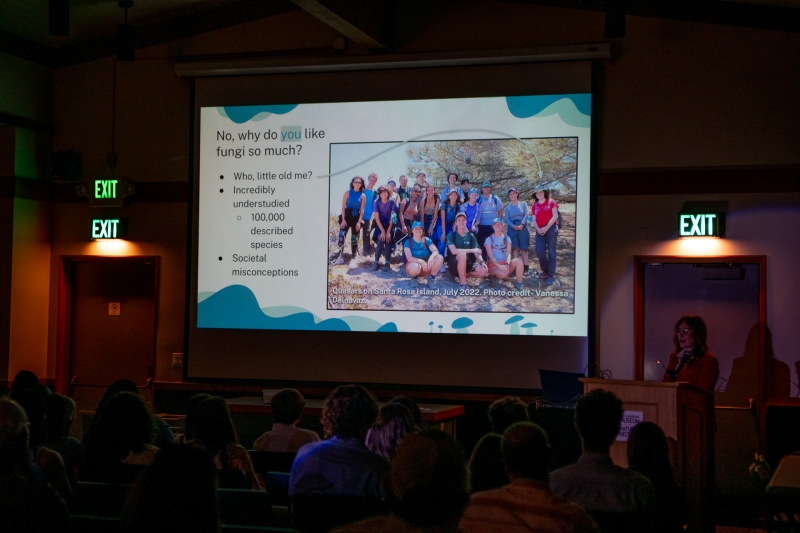
My presentation in August 2022
My idea was simple, at first: identify and map fungal fruitings across the greater Santa Barbara area. But before we can get into the specifics of what this project is, let’s outline the basics–what even are these fungy, or fungee, or funjy, or funjee?
Like plants and animals, fungi are eukaryotes, organisms with cells with membrane-bound organelles and clearly defined nuclei. However, fungi are neither plants nor animals, and contrary to popular belief, they are more closely related to the latter than the former. Two defining features of the kingdom are the presence of chitin, a long chain polymer, in their cell walls, and external digestive processes. Fungi include molds, mildews, mushrooms, rusts, yeasts, and more.
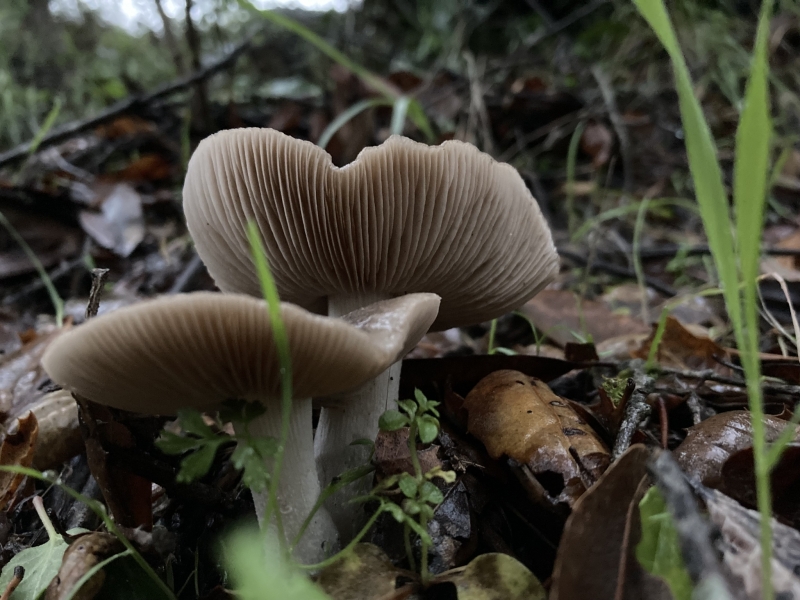
Entoloma sp. in Skofield Park
Mushrooms are just one of the many kinds of fungi, but they’re the ones I’ve chosen to focus on for my project. What exactly are they? Well, it depends a bit on who you ask. Some restrict the term “mushroom” to just the archetypal toadstools, those with a stalk, cap, and spore-harboring gills, whereas others may include those which carry their spores in pores, ridges, or teeth. For the purposes of this project, though, I included the spore-containing temporary structures of fungi, which may not have anything even resembling a cap or a stalk.
In fact, what if I told you that a mushroom is just the surface? What if I told you… that the whole thing really looks like this!
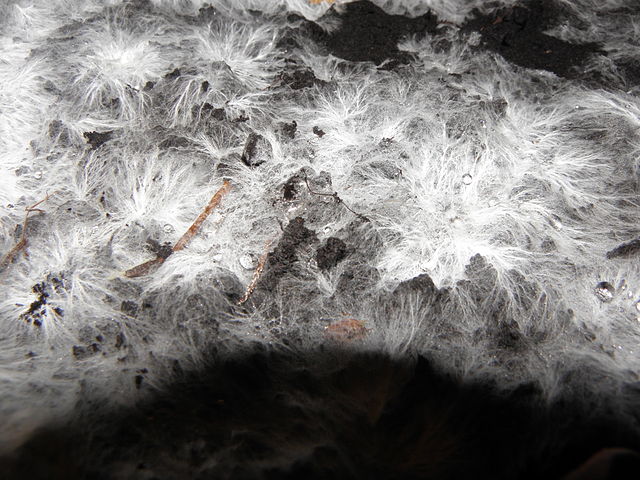
Agaricus bisporus mycelium. Image by Rob Hille, CC BY-SA 3.0, via Wikimedia Commons.
This is mycelium, and it’s the body of the organism. What we call mushrooms and view as self-contained, complete organisms are actually just the reproductive structures of fungi. Hyphae, the threadlike filaments that make up mycelium, come together above ground to form fruiting bodies, which contain spores. These mycelia can stretch for acres underground, with the world’s largest organism being a network of honey mushroom mycelia!
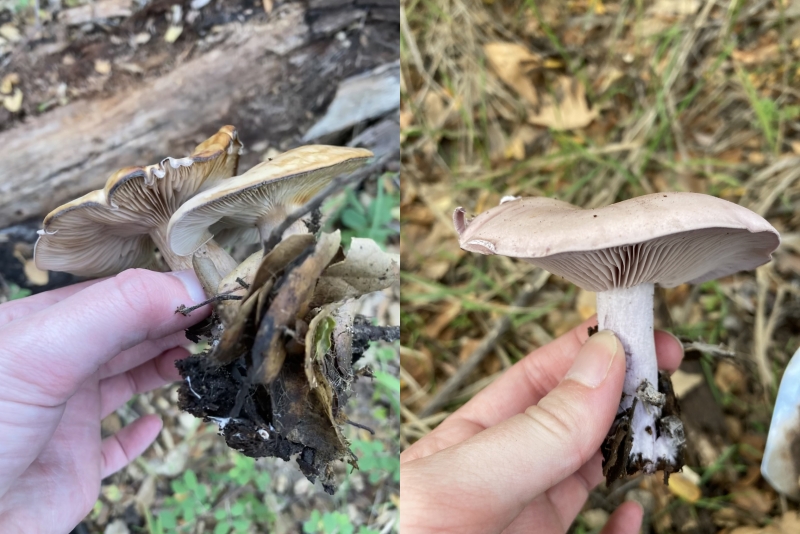
Two members of the genus Clitocybe in Stevens Park. Check out the mycelium clinging to the leaves in the left image!
Taxonomy, or the science of organism classification, plays a key role in how I interpreted my findings. It’s essentially a ranked hierarchical system that demonstrates how closely related species are to each other. The lower in rank two organisms share, the more closely related they are–two members of the same genus, for instance, are more closely related to each other than two members of just the same order.
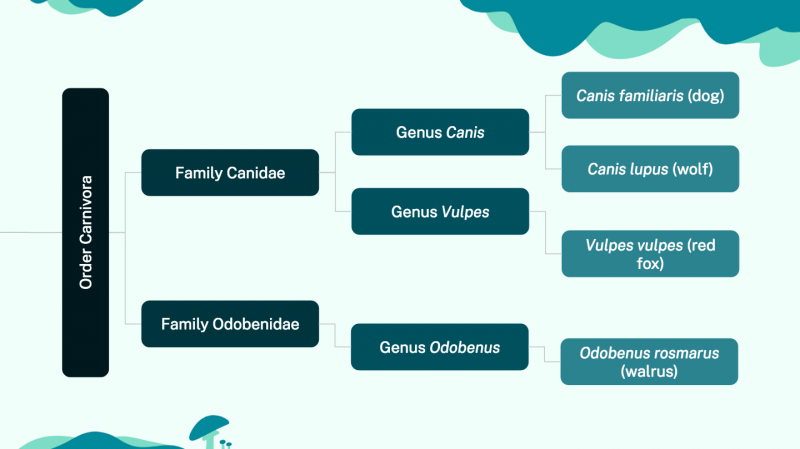
I’ve made a simplified, example version of a taxonomic chart to show a visual explanation of how several family members of the order Carnivora are related to each other. You probably already have some understanding of how dogs and wolves are pretty closely related to each other and how foxes are somewhat related to them, so switch them out with mushrooms and we’ll be on our way to understanding how individual species in a family are related to each other. Now, compare all of those with walruses, in another family entirely but within the same order. They seem pretty different, although there are a number of similarities in their morphology and behaviors. This is the kind of relatedness a lot of my data analysis hinges on–while all carnivores are in Kingdom Animalia, I was looking at a large part of Kingdom Fungi, with 7 orders and 17 families eventually being represented.
I chose to work with Orders and Families because I felt reasonably confident that I could at least identify any observations down to those levels, if not genera or species. Different orders and families are different enough to be able to draw some interesting conclusions about the behavior of the species within them, and the groupings are large enough to have a solid amount of data within them, but not so large as to be meaningless in the context of the questions we’re looking at.
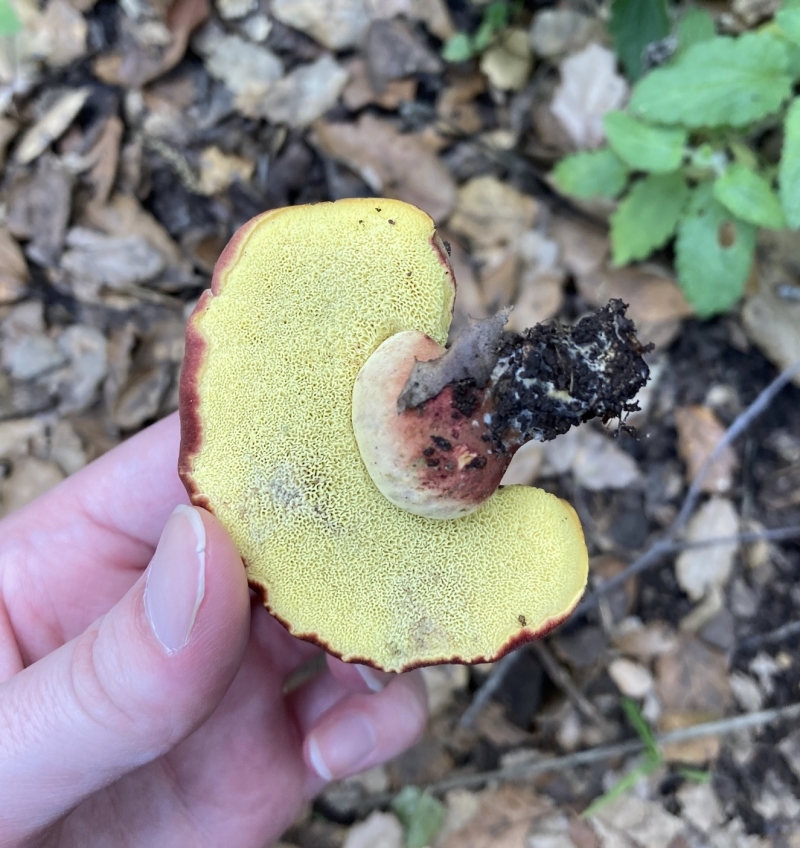
The oak-loving bolete (Xerocomellus dryophilus) in Stevens Park.
Now that we know what fungi are, the logical next step is to ask: why fungi? Why care? Why choose fungi?
Fungi play a critical role in our world, and are pervasive throughout every aspect of it. Fungi are one of, if not the, most important decomposers of organic material, and without them our world would be absolutely covered in the dead and decaying. Fungi also play an important role in the physical structure of soil systems. Of course, there are mycorrhizae, which are fungal associations with plants that are critical for plant health and involve an exchange of nutrients between fungi and plants. Many medicines are derived from fungi—you may know that penicillin is derived from a mold, but did you know that the cancer treatment drug Taxol, along with various immunosuppressive and cholesterol-lowering drugs, were all derived from fungi? Even insulin is derived from yeast! Yeast also plays a critical role in food products, being responsible for fermented foods like alcohol and kombucha, but also for bread. Mushrooms themselves have served as food sources for millennia. I haven’t even mentioned what people have made out of mycelium, from chairs to vegan leather, or the potential applications of fungi in breaking down some pollutants.
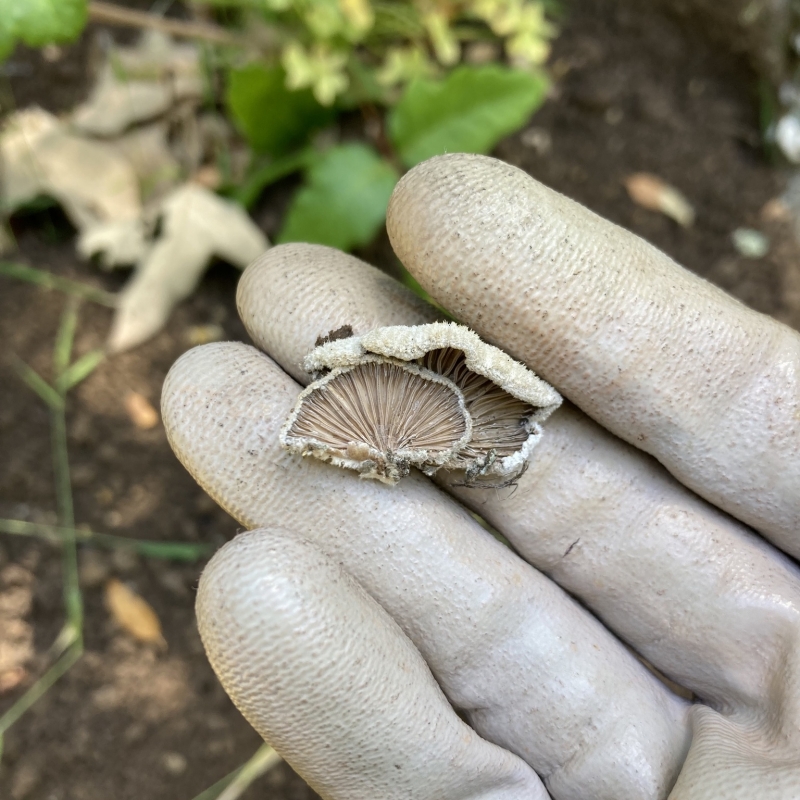
Schizophyllum commune, a mushroom that contains many promising medicinal compounds, in Parma Park.
And while all of these benefits of fungi, and more, exist, fungi are also important to understand because of the harm they can cause. I’m sure you’ve had to throw out strawberries or bread because of mold, or have to scrub mildew off the shower walls. Fungi can cause disease in plants, leading to widespread crop failure, or in animals, including humans. These infections can range from mild—think ringworm or a fungal nail infection—to deadly, particularly in the immunocompromised. And you’ve probably all been told to never eat a mushroom you find because it “will kill you”, and while proper mushroom experience and knowledge can prevent this, mushroom poisonings and deaths occur nonetheless.
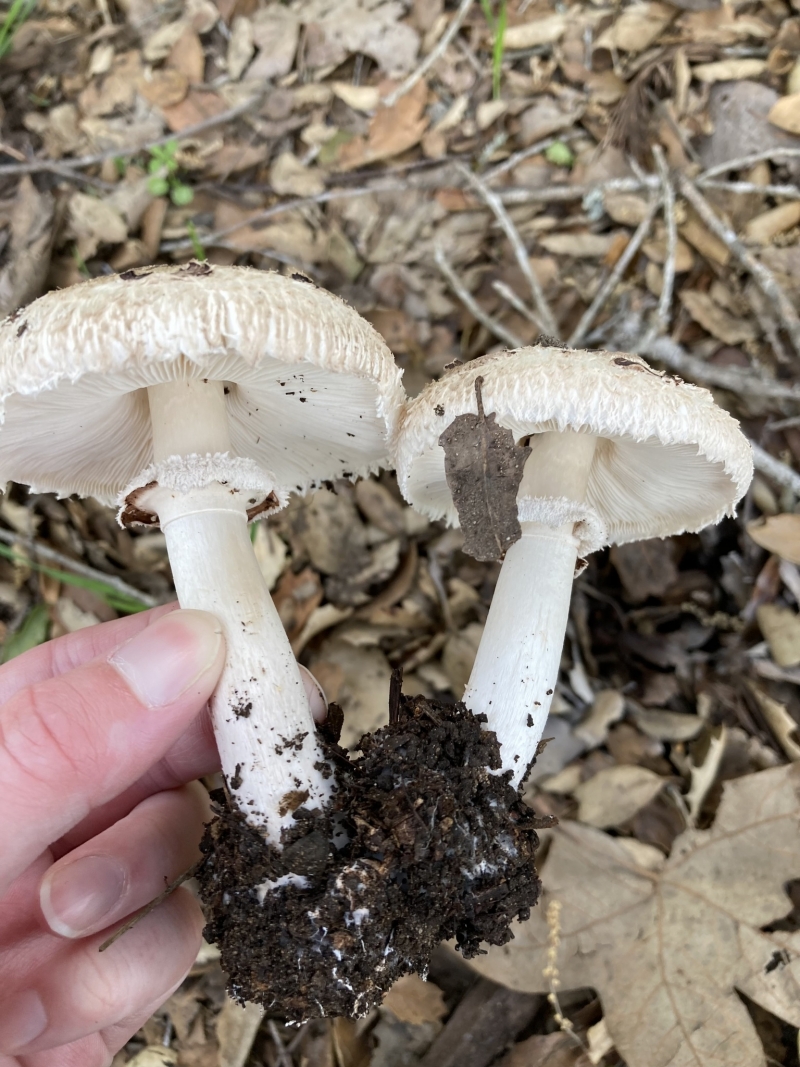
The shaggy parasol (Chlorophyllum brunneum), a choice edible mushroom. Be warned, however, that it is near-identical to the poisonous green-spored parasol (Chlorophyllum molybdites), and shares its white gills with many deadly Amanitas.
While the critical importance of fungi on the functioning of the world as we know it is all well and good, there are many other organisms and components of our world that also serve an important role. Why would I, personally, be so invested in these organisms? Why fungi? Anyone who knows me knows that I can’t keep quiet about mushrooms and all-things-fungal; I have a mushroom tee shirt, mushroom socks, earrings, bedsheets—my walls are decorated in vintage illustrations of lichens and mushrooms, I have a mushroom calendar, I paint them sometimes—but why?
Perhaps it has something to do with their understudied nature; estimates of the true number of species in Kingdom Fungi range from 1.5 to 5.1 million species, but only about 100,000 of those have been described. Or perhaps it has to do with the fact that people have so many false beliefs about fungi, viewing them in a dangerous and foreign light that they don’t extend to plants and animals, and maybe I just want to know how much of that is justified. For me, mushrooms feel like a kind of organismal underdog, and that’s something I can identify with.
Why this specific project, though—why mushroom fruitings? This project has its roots in a weeklong summer project during my sophomore year of the program, 2020, in which we were tasked in engaging in independent research on whatever subject we wanted. I thought mushroom fruitings sounded cool, so that became my project. And as for the miraculous and inspiring results I found…
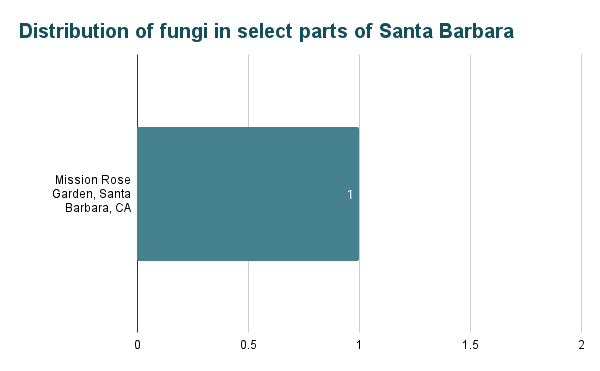
One fruiting! Wow! That’s… not very good! So, I thought about why my results may have been so inconclusive. Was it the heat, the lack of rain, my survey area? I didn’t know. But the fact that I had seen any mushrooms during a time with these factors made me wonder why they were able to exist at all.
A few months later, in September, I saw what I would later identify as Laetiporus gilbertsonii, or our western variant of Chicken of the Woods, fruiting from a tree on a walk to a friend’s house.
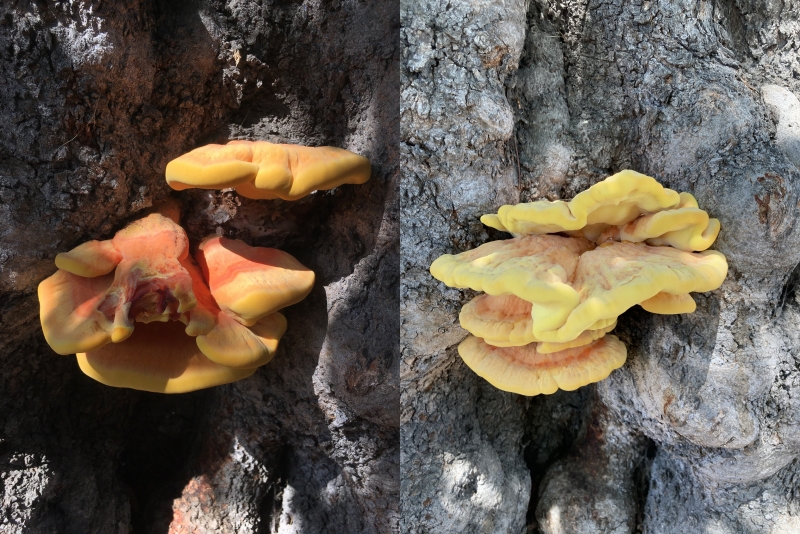
Chicken of the Woods (Laetiporus gilbertsonii) fruiting from the same tree in 2020 and 2022.
This reignited that same line of inquiry–how was another fungus fruiting? Those questions clawed at the back of my mind until about a year and a half later, when I had to start thinking about my senior project for real. I looked around my room and saw the mushrooms on my walls staring back, and I knew that there was only ever going to be one topic. I had to figure out the answers to my questions.
So now that we’ve discussed this project’s reason for existing, let’s move into my experimental design: how did I go about this research?
To design my experiment, I used that sophomore project as a jumping-off point. I thought that its limited range, both in the project’s length and small area in which to collect data, may have limited the project’s potential, so I wanted to expand its scope by collecting data in a variety of locations and over a longer period of time that included the wet season. I started data collection in November and ended it in June, and collected data at both set sites and wherever I would stumble across mushrooms in my day-to-day life. The set sites included human-managed park areas, like the Mission Rose Garden, and less managed areas, like the Stevens Park trail.
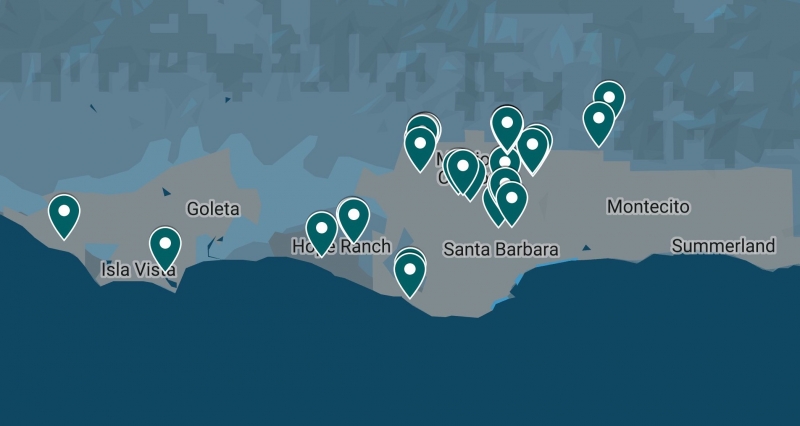
Pictured above is the final spread of sites at which I collected data. While there is a concentration of data points in the Mission Canyon and East Side areas, sites span from Goleta to Montecito.
I ended 7 months of data collection with 38 fruiting body occurrences. 7 orders and 17 families are represented, as pictured in the pie charts below.
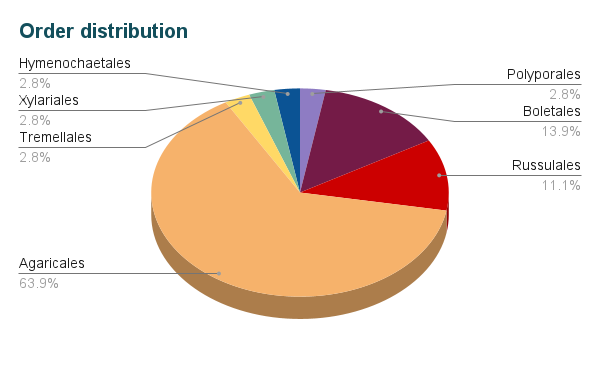
As you can see, Agaricales dominates the orders, with 23 fruitings, or 63.9% of all occurrences, belonging to that order. It should be noted, though, that Agaricales is one of the largest orders of fungi in general, which could play a role in its prevalence here.
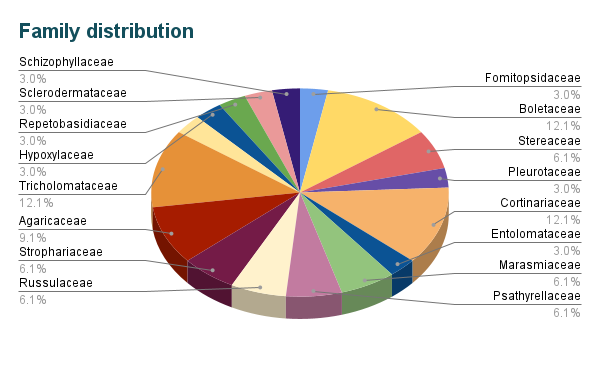
Families are more evenly distributed, but Tricholomataceae, Boletaceae, and Cortinariaceae make up the largest families, with 4 occurrences and 12.1% each.
Below is a graph of how all of these occurrences are distributed across the months, starting in November (month 11) and ending in June (month 6).
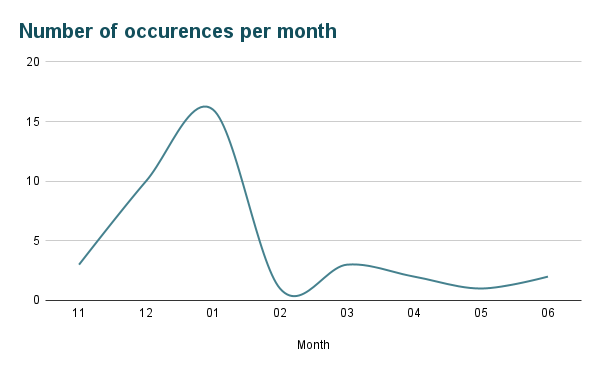
As you can see, occurrences peak in late December and early January, which corresponds with the large amount of rainfall Santa Barbara received during December. After this, there’s a dramatic drop, with just one occurrence during February. This makes sense in the context of a stark lack of rainfall this year during that month–since 1900, Februarys have averaged 4 inches of rain, but 2022 saw just 0.05 inches. And while rainfall has definitely been decreasing overtime, last February, with 0.03 inches, was the driest on record since 1997. What does this overall decrease in rainfall mean for mushroom fruitings?
Let’s take a look at the two graphs below. These compare the average cumulative inches of rainfall before a fruiting per order, measured in the 1 and 2 week period prior to the occurrence.
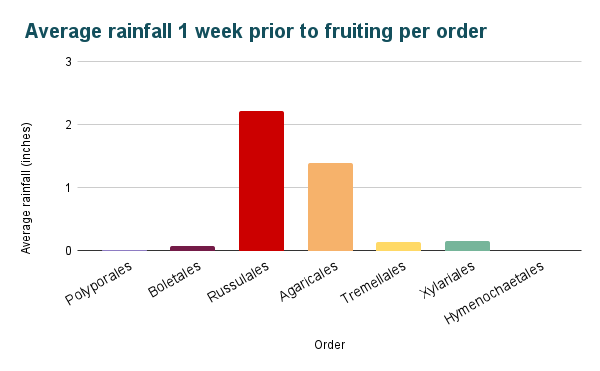

Between these two periods, the growth in inches of rain is relatively proportional across orders, but we can see how different orders require significantly different amounts of rainfall in order to fruit–the Russulales require around 40 times as much rainfall as the Boletales in the two-week period, for instance.
How do orders compare to families using these same parameters?
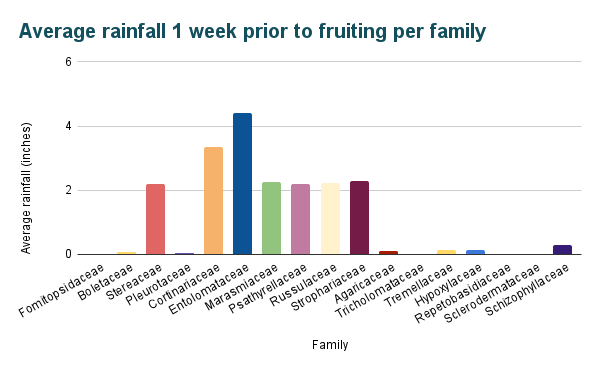
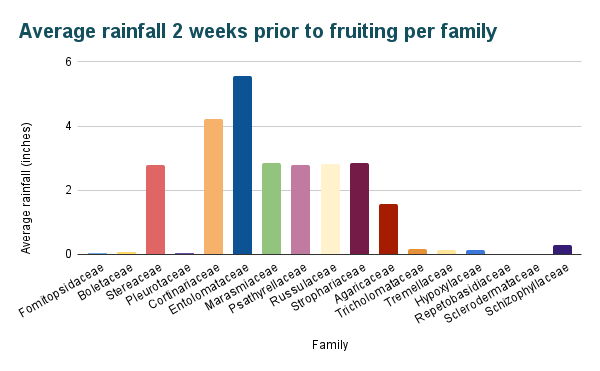
Similarly to before, there isn’t a lot of change in fruitings from 1 week to 2 weeks, which could suggest that the amount of rainfall in 1 week is a larger factor in fruiting. There is one notable exception–the Agaricaceae family, which averages about 0.1 inches of rain in the 1 week period prior to fruiting, but about 1.6 inches in the 2 weeks prior. This could suggest that some families are more sensitive to rain, while others require greater amounts over a longer period of time to fruit.
Here’s an overall look at how individual family occurrences compare to the amount of rainfall received in the two weeks prior.
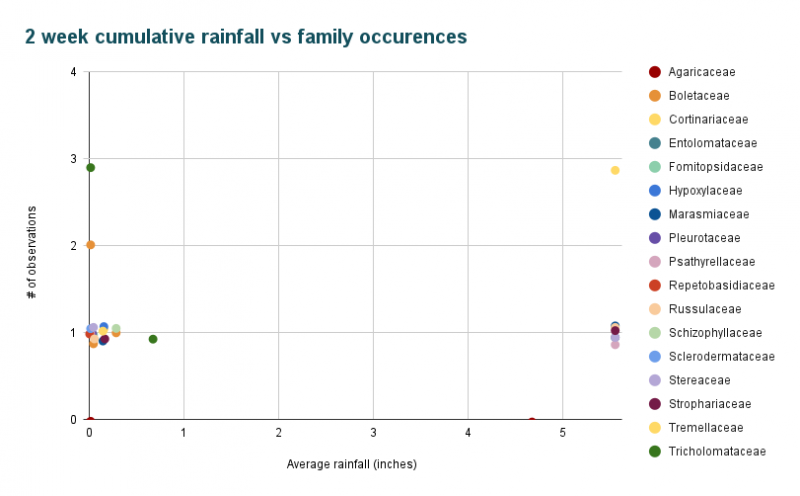
Different families stick to different extremes–no families were observed fruiting between 1 and 4 inches of rainfall. For most families, there was only 1 occurrence, but for those that had more than 1, they tended to all fruit with the same amount of rainfall.
While rainfall is a decidedly important factor in mushroom fruitings, it certainly is not the only one. I wanted to look at another factor that changes over time and could potentially impact fruitings–temperature. I chose to compare my data to the average high temperature of the past 7 days prior to the occurrence. As we look at these graphs, we can see a definite difference in temperature between orders and between families.
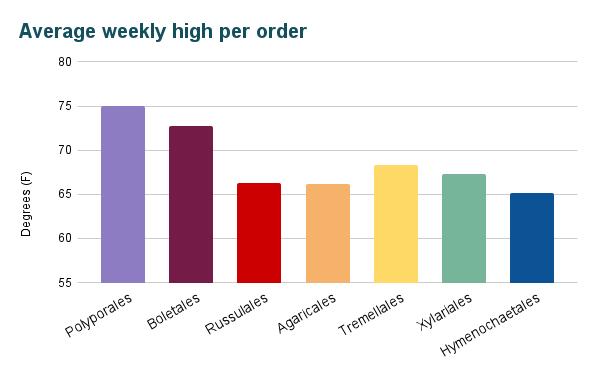
Order-wise, the Polyporales fruit at an average of ten degrees higher than the Hymenochaetales.
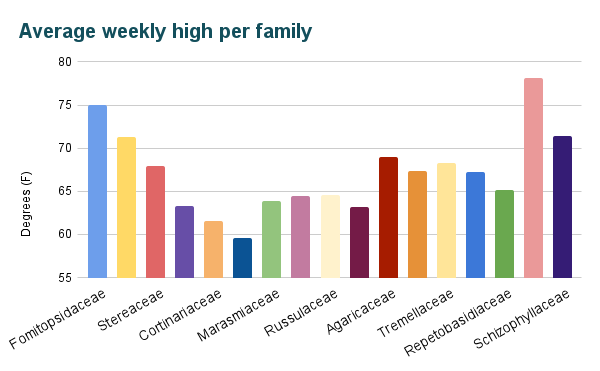
Family-wise, there’s an almost 18-degree difference between the Sclerodermataceae and the Entolomataceae.
These differences could explain mushroom seasonality, with different species consistently fruiting at different times of the year, but they could also be a correlative result–perhaps these fruitings are independent of temperature and instead the result of other seasonal changes.
No research is free of error, and mine is no exception. My data is biased by my sporadic ability to collect data; if I had had a more regular collecting schedule, like once a week, I may have had more observations and more conclusive data. The amount of times I went out to observe mushrooms at certain sites may have also impacted my data. Misidentification of some specimens is also possible.
When I first began this project almost a year ago, my plan was to collect data and compare it to historical data to see how species diversity has shifted across time, but historical fruiting records in our area proved impossible to find. In future experiments, I would like to measure more variables and see how they could affect fruitings–what were the soil nutrient levels and moisture content of the different locations? How disturbed was the surrounding ground? How could competition between species, both fungal and non-fungal, affect fruitings? What were the nutritional types of fungi I was observing–were they decomposers, mycorrhizal, or parasitic?
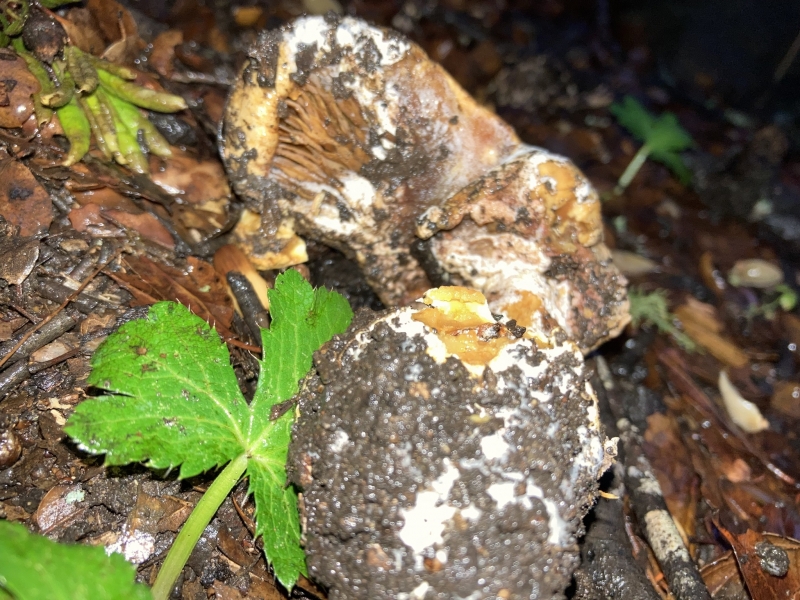
A very moldy Cortinarius xanthodryophilus, a mycorrhizal species.
So, I’ve spent the last year of my life working on this, but why? What are the implications of all of this? What was it all for? My findings have demonstrated that mushrooms fruit differently as a result of different factors: rainfall and temperature. So let’s take those factors and re-contextualize them where this project began: in Santa Barbara. By 2050, Santa Barbara County is expected to have experienced 3 degrees Fahrenheit of warming, and overall rainfall across California is projected to decrease 12–35%. As these factors change, so, too, will the demography and diversity of mushrooms. How resilient will fungus be to a changing world? That seems to be unclear–only 597 fungal species are listed on the IUCN Endangered Species Red List compared to over 61,000 plant and over 85,000 animal species. What does this say about their outlook–that they are less likely to become endangered, or simply understudied?
Regardless of how the world changes, some fungi will persist. It is said that morel mushroom species (Morchella) thrive in post-burn areas, and as wildfire risk increases, so may they. Water intrusion in flooding homes will lead to the spread of mold and other fungi. Invasive species like the Death Cap (Amanita phalloides) will continue to spread as warming temperatures make colder regions more hospitable to them. Fungi will build, and they will destroy.
Fungi have existed for over a billion years and will certainly continue to. The kingdom has survived a transition from water to land, mass extinctions, ice ages. As the world changes, so, too, will they. The impact of their changes on us, though–that remains to be seen.
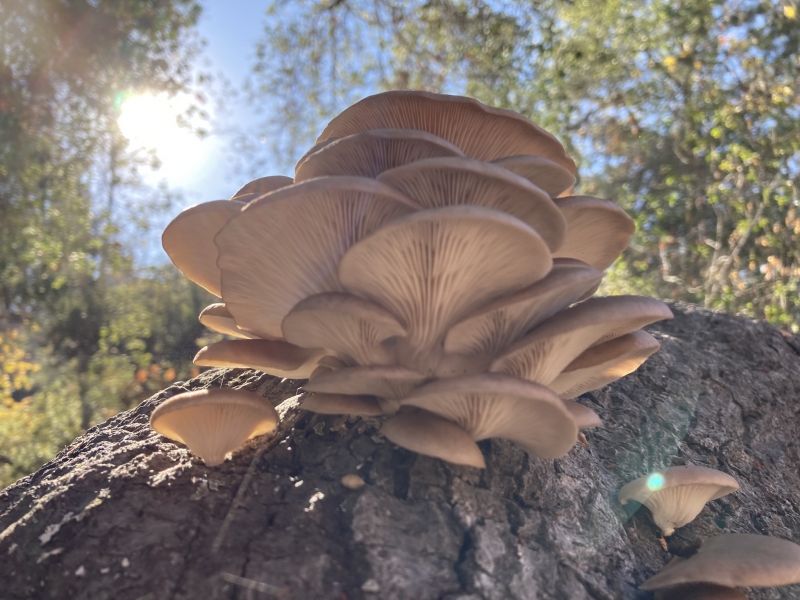
Oyster mushrooms (Genus Pleurotus) fruit from a log at the Santa Barbara Museum of Natural History.
Bibliography/Further Reading
Arora, David. Mushrooms Demystified: A Comprehensive Guide to the Fleshy Fungi. Ten Speed Press, 1986.
Grubisha, Lisa & Trappe, James & Bruns, Tom. (2003). Preliminary record of ectomycorrhizal fungi on two California Channel Islands. 171-183.
Images by Stella Scheim, except where noted otherwise.
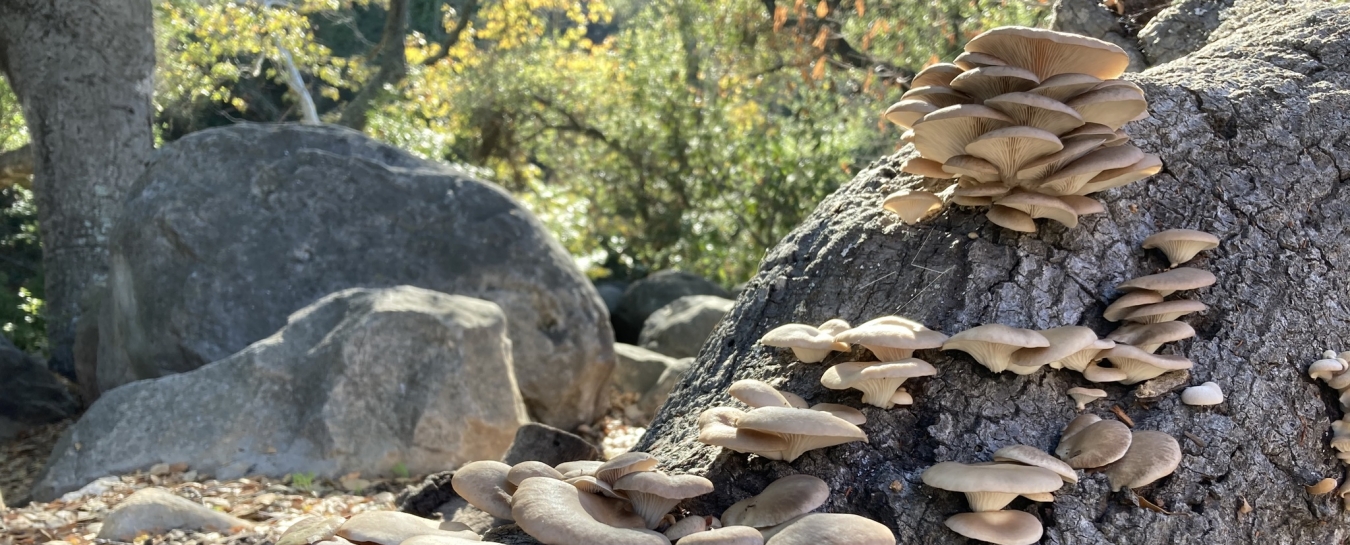





10 Comments
Post a CommentThis information is fascinating and presented in a professional, clear way. Thanks for sharing your passion!
Very impressive work, thanks Stella!
Congrats Stella, both on an awesome research project and an accessible, easy to understand, and FUN presentation of it and its implications here.
Thank you for a fascinating article. You are a very fine writer, Stella, but stay with that fungi for sure! Congratulations on your fine work.
This is great Stella! Very professional and informative, I learned a ton from reading this. So cool, great work!
This is very well done, Stella! I enjoyed learning all the scientific information from you, but also how you conveyed the facts as a conversation with your reader. That's a very effective way of getting your results across. Congratulations to completing a successful project!
Oh my celium! Stella, you've gone above and beyond! Not only do you make great contributions to science and help the museum shine, but you are one fun gal too! Your example provides muchroom for the younger Quasars to grow to follow.
There's certainly a lot to know about this topic. I really like all the points you made.
This looks great Stella! So proud and keep up the good work girl!
Very nice article Stella, thanks for sharing....